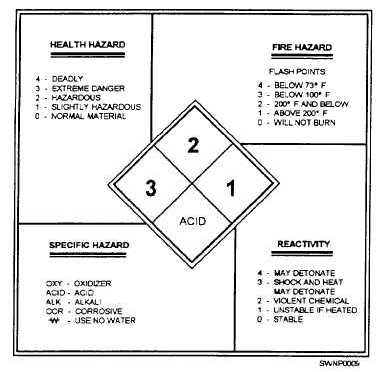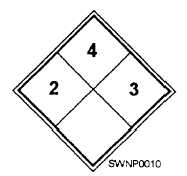
Figure 1-9. - Hazardous Code Chart.
The four specific hazards that the labels are designed to illustrate are as follows:
Health Hazard - the ability of a material to either directly or indirectly cause temporary or permanent injury or incapacitation.
Fire Hazard - the ability of a material to bum when exposed to a heat source.
Reactivity Hazard - the ability of a material to release energy when in contact with water. This term can be defined as the tendency of a material, when in its pure state or as a commercially produced product, to polymerize, decompose, condense, or otherwise become self-reactive and undergo violent chemical changes.
Specific Hazard - this term relates to a special hazard concerning the particular product or chemical that was not covered by other labeled hazard items.
The degree of hazard is expressed in numerical codes as follows:
4 = extremely dangerous material
3 = dangerous hazard
2 = moderate hazard
1 = slight hazard
0 = no hazard
The example shown in figure 1-10 describes the hazards of methyl ethyl ketone. Methyl ethyl ketone is usually found mixed with paints, oils, and greases from solvent cleaning, paint removers, adhesives, and cleaning fluid residues. The numbers on the label identify this chemical compound as follows:
Health Hazard 2, "Hazardous"
Fire Hazard 4, "Flash point below 73°F, extremely dangerous material"
Reactivity 3, "Shock or heat may detonate, dangerous material"
Specific Hazard, "None"

Figure 1-10. - Hazard warning lahel for methyl ethyl ketone.
Continue Reading